Lessico
Melograno
Punica granatum
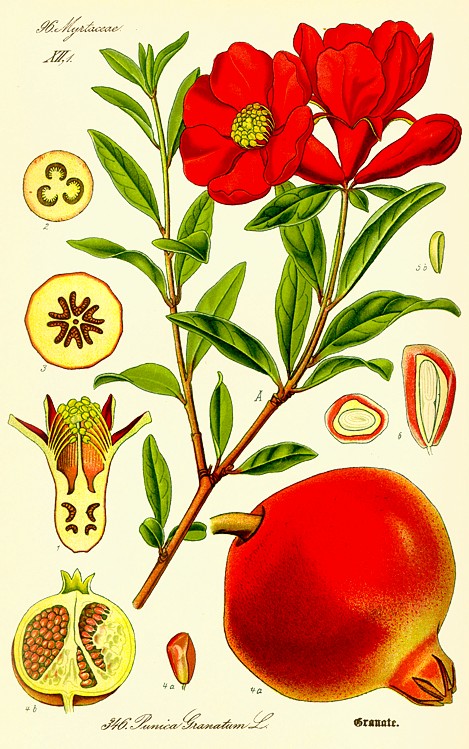
Pianto antico
L'albero
a cui tendevi
la pargoletta mano,
il verde melograno
da' bei vermigli fior,
nel muto orto solingo
rinverdì tutto or ora,
e giugno lo ristora
di luce e di calor.
Tu fior
de la mia pianta
percossa e inaridita,
tu de l'inutil vita
estremo
unico fior,
sei ne la terra fredda,
sei ne la terra negra
né il sol più ti rallegra
né ti risveglia amor.
da Rime nuove - 1887
Il 9 novembre 1870, il piccolo Dante, figlio di Giosuè Carducci e di Elvira Menicucci, era morto a soli 3 anni di età, molto probabilmente di tifo, nella casa paterna di via Broccaindosso a Bologna. In questa breve e intensa poesia, scritta nel 1871, Giosuè Carducci (1835-1907) esprime il dolore per la morte del figlioletto Dante e l'aggettivo antico riferito al pianto sta a significare che lo strazio del poeta è lo stesso provato dagli uomini d'ogni tempo di fronte alla morte.
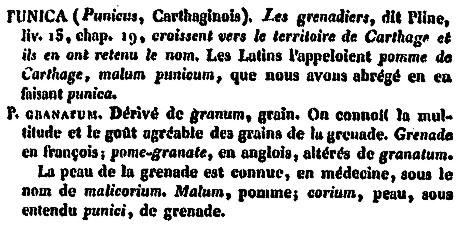
Glossaire de botanique - Alexandre de Théis - 1810
Il Melograno (Punica, L.) è un genere delle Punicaceae che comprende due specie di arbusti originari di una regione che va dall'Iran alla zona himalayana dell'India settentrionale, diffuso sin dall'antichità nell'intera zona mediterranea e nel Caucaso. Secondo la classificazione AGP il genere va inserito tra le Lythraceae.
Punica granatum è la specie più conosciuta. Ha portamento cespuglioso, alta fino a 2-4 m, foglie caduche lanceolate, non molto grandi di colore verde lucente, fiori solitari grandi o riuniti in mazzetti all'estremità dei rami, di colore rosso vivace, con varietà a fiori semplici o doppi, di colore rosso, rosa, bianco o screziati, fioritura in giugno-agosto con i caratteristici frutti eduli dal gusto acido.
Punica protopunica è una specie quasi sconosciuta in pericolo di estinzione. Sopravvivono alcuni esemplari nell'isola di Socotra nell'Oceano indiano (Yemen), si presenta come un alberello di circa 3-5 m, fiori di colore rosso brillante, frutti di colore cangiante dal verde al rosso scuro a maturità.
La Punica granatum richiede esposizione soleggiata, ben riparata in quanto mal sopporta inverni troppo rigidi, terreno fresco, fertile, ma ben drenato, cresce bene anche in suoli asciutti.
Si moltiplica con la semina, più frequentemente in primavera per talea semilegnosa o per margotta, con una certa difficoltà per innesto.
La Punica granatum viene utilizzata come pianta ornamentale nei giardini, le varietà nane in vaso sui terrazzi; industrialmente si coltiva per la produzione dei frutti eduli. Si usano per le proprietà medicinali sia la corteccia delle radici prelevata in primavera o in autunno che la scorza dei frutti raccolta in autunno, ricche di tannino, tagliate a pezzetti e fatte essiccare all'aria.
La polvere ottenuta utilizzata come decotto, ha proprietà tenifughe, astringenti e sedative nelle dissenterie; per uso esterno il decotto ha proprietà astringenti, per clisteri o irrigazioni vaginali.
Porre estrema attenzione ai preparati a base di corteccia di radici: sono estremamente pericolosi provocando fenomeni di idiosincrasia.
L'infuso dei petali viene utilizzato come rinfrescante delle gengive. I semi eduli ricchi di vitamina C, hanno proprietà blandamente diuretiche e si usano anche per la preparazione di sciroppi e della granatina. Le scorze dei frutti hanno anche proprietà aromatiche e vengono utilizzate per dare il gusto amarognolo a Vermut e aperitivi.
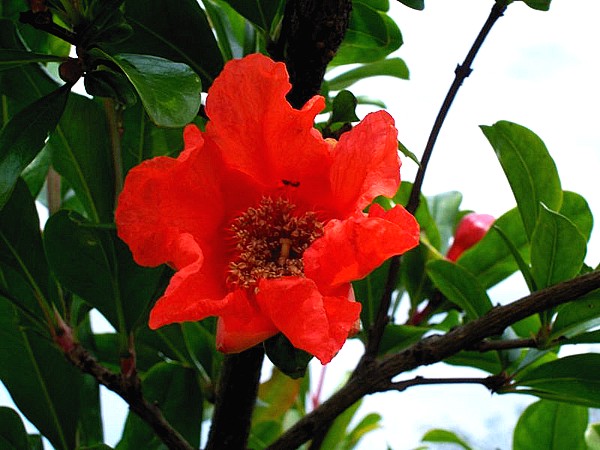
The Pomegranate (Punica granatum) is a fruit-bearing deciduous shrub or small tree growing to 5–8 m tall. The pomegranate is native to the region from Afghanistan, Pakistan, and Iran to the Himalayas in northern India and has been cultivated and naturalized over the whole Mediterranean region and the Caucasus since ancient times. It is widely cultivated throughout Armenia, Azerbaijan, Iran, India, the drier parts of southeast Asia, Peninsular Malaysia, the East Indies, and tropical Africa. Introduced into Latin America and California by Spanish settlers in 1769, pomegranate is now cultivated mainly in the drier parts of California and Arizona for its fruits exploited commercially as juice products gaining in popularity since 2001. In the global functional food industry, pomegranate is included among a novel category of exotic plant sources called superfruits.
In the Northern Hemisphere, the fruit is typically in season from September to January. In the Southern hemisphere, it is in season from March to May.
The leaves are opposite or sub-opposite, glossy, narrow oblong, entire, 3–7 cm long and 2 cm broad. The flowers are bright red, 3 cm in diameter, with four to five petals (often more on cultivated plants). The fruit is between a lemon and a grapefruit in size, 5–12 cm in diameter with a rounded hexagonal shape, and has thick reddish skin and around 600 seeds. The seeds and surrounding pulp, ranging in colour from white to deep red, called arils, are edible; indeed, the fruit of the pomegranate is a berry. There are some cultivars which have been introduced that have a range of pulp colours such as purple.
Punica granatum nana is a dwarf variety of Punica granatum popularly used as Bonsai trees and as a patio plant. The only other species in the genus Punica is the Socotran pomegranate (Punica protopunica), which is endemic to the island of Socotra. It differs in having pink (not red) flowers and smaller, less sweet fruit. Pomegranates are drought tolerant, and can be grown in dry areas with either a Mediterranean winter rainfall climate or in summer rainfall climates. In wetter areas, they are prone to root decay from fungal diseases. They are tolerant of moderate frost, down to about -10°C (14°F).
Etymology
The name "pomegranate" derives from Latin pomum ("fruit") and granatum ("seeded"). This has influenced the common name for pomegranate in many languages (e.g. German Granatapfel, seeded apple). The genus name Punica is named for the Phoenicians, who were active in broadening its cultivation, partly for religious reasons. In classical Latin, where "malum" was broadly applied to many apple-like fruits, the pomegranate's name was malum punicum or malum granatum, the latter giving rise to the Italian name melograno, or less commonly melagrana.
A widespread root for "pomegranate" comes from the Ancient Egyptian rmn, from which derive the Hebrew rimmôn, and Arabic rummân. This root was given by Arabs to other languages, including Portuguese (romã), Kabyle rrumman and Maltese rummien. The pomegranate ('rimmôn') is mentioned in the Bible as one of the seven fruits/plants that Israel was blessed with, and in Hebrew, 'rimmôn' is also the name of the weapon now called the grenade. According to the OED, the word grenade originated about 1532 from the French name for the pomegranate, la grenade. La grenade also gives us the word grenadine, the name of a kind of fruit syrup, originally made from pomegranates, which is widely used as a cordial and in cocktails.
Even though this fruit does not originate from China, one common nickname is "Chinese apple." In German and Dutch, the term "Chinese Apple" (Apfelsine in German), refers to the orange
Cultivation and uses
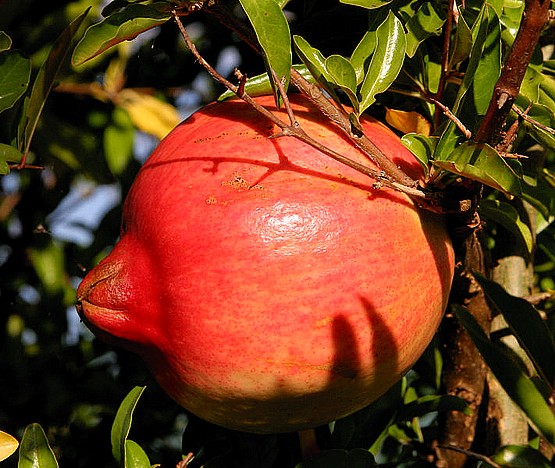
The
pomegranate originated from Persia and has been cultivated in Georgia, Armenia
and the Mediterranean region for several millennia.
In Georgia, and Armenia to the east of the Black Sea, there are wild
pomegranate groves outside of ancient abandoned settlements. The cultivation
of the pomegranate has a long history in Armenia, where decayed remains of
pomegranates dating back to 1000 BC have been found.
Carbonized exocarp of the fruit has been identified in Early Bronze Age levels of Jericho, as well as Late Bronze Age levels of Hala Sultan Tekke on Cyprus and Tiryns. A large, dry pomegranate was found in the tomb of Djehuty, the butler of Queen Hatshepsut; Mesopotamian cuneiform records mention pomegranates from the mid-Third millennium BC onwards. It is also extensively grown in South China and in Southeast Asia, whether originally spread along the route of the Silk Road or brought by sea traders.
The ancient city of Granada in Spain was renamed after the fruit during the Moorish period. Spanish colonists later introduced the fruit to the Caribbean and Latin America, but in the English colonies it was less at home: "Don't use the pomegranate inhospitably, a stranger that has come so far to pay his respects to thee," the English Quaker Peter Collinson wrote to the botanizing John Bartram in Philadelphia, 1762. "Plant it against the side of thy house, nail it close to the wall. In this manner it thrives wonderfully with us, and flowers beautifully, and bears fruit this hot year. I have twenty-four on one tree... Doctor Fothergill says, of all trees this is most salutiferous to mankind." The pomegranate had been introduced as an exotic to England the previous century, by John Tradescant the elder, but the disappointment that it did not set fruit there led to its repeated introduction to the American colonies, even New England. It succeeded in the South: Bartram received a barrel of pomegranates and oranges from a correspondent in Charleston, South Carolina, 1764. Thomas Jefferson planted pomegranates at Monticello in 1771: he had them from George Wythe of Williamsburg.
Culinary use
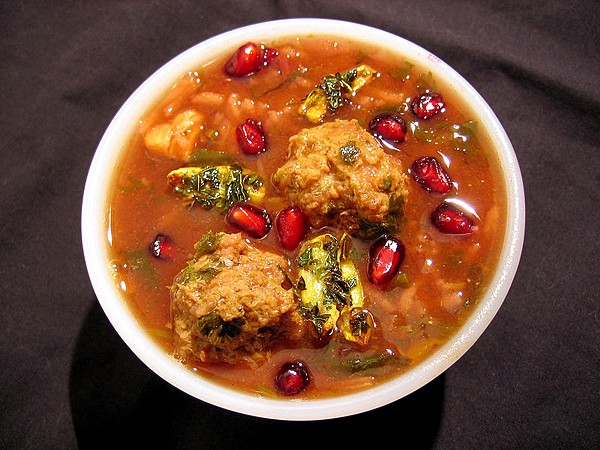
A bowl of ash-e anar, a Persian soup made with pomegranate juice.
After opening the pomegranate by scoring it with a knife and breaking it open, the arils (seed casings) are separated from the skin (peel) and internal white supporting structures (pith and carpellary membrane). Separating the red arils can be simplified by performing this task in a bowl of water, whereby the arils will sink and the white structures will float to the top. The entire seed is consumed raw, though the fleshy outer portion of the seed is the part that is desired. The taste differs depending on the variety of pomegranate and its state of ripeness. It can be very sweet or it can be very sour or tangy, but most fruits lie somewhere in between, which is the characteristic taste, laced with notes of its tannin.
Pomegranate juice is a popular drink in the Middle East, and is also used in Iranian and Indian cuisine; it began to be widely marketed in the United States in 2002. Fresh pomegranate arils are used in preparation of curd rice (Telugu: Dadhojanam) in Andhra Pradesh in India. Pomegranate concentrate is used in Syrian cuisine. Grenadine syrup is thickened and sweetened pomegranate juice; it is used in cocktail mixing. Before the tomato arrived in the Middle East, grenadine was widely used in many Persian foods; it can still be found in traditional recipes such as fesenjan (a thick sauce made from pomegranate juice and ground walnuts, usually spooned over duck or other poultry and rice) and ash-e anar (pomegranate soup).
Wild pomegranate seeds are sometimes used as a spice, known as anardana (which literally means pomegranate (anar) seeds (dana) in Persian), most notably in Indian and Pakistani cuisine but also as a replacement for pomegranate syrup in Persian and Middle Eastern cuisine. As a result of this, the dried whole seeds can often be obtained in ethnic markets. The seeds are separated from the flesh, dried for 10–15 days and used as an acidic agent for chutney and curry production. The seeds may also be ground in order to avoid seeds becoming stuck in the teeth when eating dishes prepared with them. The seeds of the wild pomegranate daru from the Himalayas are considered the highest quality source for this spice.
In Armenia and the Caucasus, pomegranate (Armenian: nur) is used in a variety of ways, notably as pomegranate juice. In Turkey pomegranate sauce, (Turkish: nar eksisi) is used as a salad dressing, to marinate meat, or simply to drink straight. Pomegranate seeds are also used in salads and sometimes to garnish desserts such as Güllaç. Pomegranate syrup or molasses are used in Muhammara, a Roasted Red Pepper, Walnut, and Garlic Spread popular in Syria as well as Turkey. In Azerbaijan and Armenia, pomegranate is also used to make high-quality wine which is successfully exported to other countries.
In Greece, pomegranate (Greek rodi) is used in many recipes; such as kollivozoumi, a creamy broth made from boiled wheat, pomegranates and raisins; legume salad with wheat and pomegranate; traditional Middle Eastern lamb kebabs with pomegranate glaze; pomegranate eggplant relish; avocado and pomegranate dip; are just some of the dishes in which it is used. Pomegranate is also made into a liqueur and popular fruit confectionery that can be used as ice cream topping, or mixed with yogurt, and even spread as jams over toast for breakfast.
Health benefits
Providing 16% of an adult's daily vitamin C requirement per 100 ml serving, pomegranate juice is also a good source of the B vitamin, pantothenic acid, potassium and antioxidant polyphenols. Overall, however, pomegranate is not a significant source of nutrients.
The most abundant polyphenols in pomegranate juice are the hydrolyzable tannins called punicalagins shown in 39 peer-reviewed research publications over 1990-2007 (August) to have potent free-radical scavenging ability in laboratory studies. Antioxidant punicalagins absorb into the human body after consumption of pomegranate extracts, and an ex vivo study of human plasma after consumption of a pomegranate extract standardized to punicalagins indicated an average 32% increase in plasma antioxidant capacity.
Many food and dietary supplement makers have found advantages of using pomegranate extracts (which have no sugar, calories, or additives), instead of juice, as healthy ingredients in their products. Many pomegranate extracts are essentially ellagic acid which absorbs into the body after parent molecule punicalagins are hydrolyzed.
In preliminary laboratory research and human pilot studies, juice of the pomegranate has been found effective in reducing heart disease risk factors, including LDL oxidation, macrophage oxidative status, and foam cell formation, all of which are steps in atherosclerosis and cardiovascular disease. Tannins such as punicalagins have been identified as the primary components responsible for the reduction of oxidative stress which led to these risk factors. Pomegranate has been shown to reduce systolic blood pressure by inhibiting serum angiotensin-converting enzyme (ACE).
Metabolites of pomegranate juice ellagitannins have been shown to localize specifically in the prostate gland, colon and intestinal tissues of mice. Other research indicates that pomegranate juice may be effective against prostate cancer and osteoarthritis. In 2007, five clinical trials in the United States and Norway were conducted to examine the effects of pomegranate juice consumption on parameters of prostate cancer or prostatic hyperplasia, diabetes or lymphoma. The studies have not concluded (December 2007) but interim reports released to the public media were that pomegranate juice may slow onset or development of prostate cancer (above).
Containing polyphenols which inhibit oestrogen synthesis, pomegranate seed oil was effective against proliferation of breast cancer cells in vitro. The juice may also have antiviral and antibacterial effects against dental plaque.
Pomegranates and symbolism
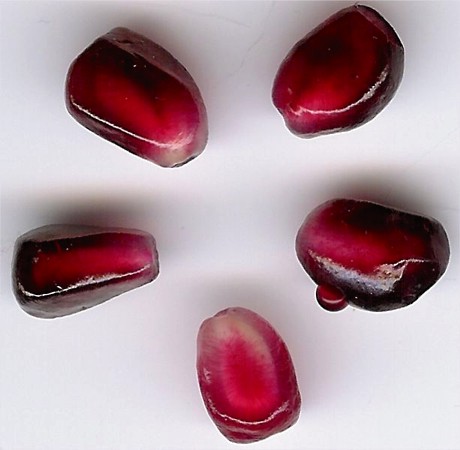
Exodus 28:33–34 directed that images of pomegranates be woven onto the borders of Hebrew priestly robes. 1 Kings 7:13–22 describes pomegranates depicted in the temple King Solomon built in Jerusalem. Jewish tradition teaches that the pomegranate is a symbol for righteousness, because it is said to have 613 seeds which corresponds with the 613 mitzvot or commandments of the Torah. However, the actual number of seeds varies with individual fruits. For this reason and others, many Jews eat pomegranates on Rosh Hashanah. The pomegranate is one of the few images which appear on ancient coins of Judea as a holy symbol, and today many Torah scrolls are stored while not in use with a pair of decorative hollow silver "pomegranates" (rimmonim) slid down over the two upper scroll handles.
For the same reason, pomegranates are a motif found in Christian religious decoration. They are often woven into the fabric on vestments and liturgical hangings or wrought in metalwork.
The wild pomegranate did not grow natively in the Aegean area in Neolithic times. It originated in eastern Iran and came to the Aegean world along the same cultural pathways that brought the goddess whom the Anatolians worshipped as Cybele and the Mesopotamians as Ishtar.
The myth of Persephone, the dark goddess of the Underworld, also prominently features the pomegranate. In one version of Greek mythology, Persephone was kidnapped by Hades and taken off to live in the underworld as his wife. Her mother, Demeter (goddess of the Harvest), went into mourning for her lost daughter and thus all green things ceased to grow. Zeus, the highest ranking of the Greek gods, could not leave the Earth to die, so he commanded Hades to return Persephone. It was the rule of the Fates that anyone who consumed food or drink in the Underworld was doomed to spend eternity there. Persephone had no food, but Hades tricked her into eating four pomegranate seeds while she was still his prisoner and so, because of this, she was condemned to spend four months in the Underworld every year. During these four months, when Persephone is sitting on the throne of the Underworld next to her husband Hades, her mother Demeter mourns and no longer gives fertility to the earth. This became an ancient Greek explanation for the seasons. Dante Gabriel Rossetti's painting Persephona depicts Persephone holding the fatal fruit. It should be noted that the number of seeds that Persephone ate is varied, depending on which version of the story is told. The number of seeds she is said to have eaten ranges from three to seven, which accounts for just one barren season if it is just three or four seeds, or two barren seasons (half the year) if she ate six or seven seeds. There is no set number.
The pomegranate also evoked the presence of the Aegean Triple Goddess who evolved into the Olympian Hera, who is sometimes represented offering the pomegranate, as in the Polykleitos' cult image of the Argive Heraion (see below). According to Carl A. P. Ruck and Danny Staples, the chambered pomegranate is also a surrogate for the poppy's narcotic capsule, with its comparable shape and chambered interior. On a Mycenaean seal illustrated in Joseph Campbell's Occidental Mythology 1964, figure 19, the seated Goddess of the double-headed axe (the labrys) offers three poppy pods in her right hand and supports her breast with her left. She embodies both aspects of the dual goddess, life-giving and death-dealing at once. The Titan Orion was represented as "marrying" Side, a name that in Boeotia means "pomegranate", thus consecrating the primal hunter to the Goddess. Other Greek dialects call the pomegranate rhoa; its possible connection with the name of the earth goddess Rhea, inexplicable in Greek, proved suggestive for the mythographer Karl Kerenyi, who suggested that the consonance might ultimately derive from a deeper, pre-Indo-European language layer.
In the 6th century BC, Polykleitos took ivory and gold to sculpt the seated Argive Hera in her temple. She held a scepter in one hand and offered a pomegranate, like a royal orb, in the other. "About the pomegranate I must say nothing," whispered the traveller Pausanias in the 2nd century, "for its story is something of a mystery." Indeed, in the Orion story we hear that Hera cast pomegranate-Side (an ancient city in Antalya) into dim Erebus — "for daring to rival Hera's beauty", which forms the probable point of connection with the older Osiris/Isis story. Since the ancient Egyptians identified the Orion constellation in the sky as Sah the "soul of Osiris", the identification of this section of the myth seems relatively complete. Hera wears, not a wreath nor a tiara nor a diadem, but clearly the calyx of the pomegranate that has become her serrated crown. In some artistic depictions, the pomegranate is found in the hand of Mary, mother of Jesus.
In modern times the pomegranate still holds strong symbolic meanings for the Greeks. On important days in the Greek Orthodox calendar, such as the Presentation of the Virgin Mary and on Christmas Day, it is traditional to have at the dinner table "polysporia", also known by their ancient name "panspermia," in some regions of Greece. In ancient times they were offered to Demeter and to the other gods for fertile land, for the spirits of the dead and in honor of compassionate Dionysus. When one buys a new home, it is conventional for a house guest to bring as a first gift a pomegranate, which is placed under/near the ikonostasi, (home altar), of the house, as it is a symbol of abundance, fertility and good luck. Pomegranates are also prominent at Greek weddings and funerals. When Greeks commemorate their dead, they make kollyva as offerings, which consist of boiled wheat, mixed with sugar and decorated with pomegranate. It is also traditional in Greece to break a pomegranate on the ground at weddings and on New Years. Pomegranate decorations for the home are very common in Greece and sold in most homegoods stores.
Other
The pomegranate is the symbol and heraldic device of the city of Granada in Andalusia, Spain.
In South Africa, the pomegranate is sometimes referred to as 'the poor man's cranberry'.
Pomegranate is one of the symbols of Armenia, representing fertility, abundance and marriage.
It is the official logo of many cities in Turkey.
The Immortals, an elite infantry unit in ancient Persia, had spears with pomegranate-shaped counterweights at the butt made of gold (for officers) and silver (for regular infantry). In modern Iran the fruit is still believed to a give long and healthy life.
The Qur'an mentions pomegranates three times (6:99, 6:141, 55:068) — twice as examples of the good things God creates, once as a fruit found in the Garden of Paradise.
Pomegranate juice is used for natural dyeing of non-synthetic fabrics.
Pomegranate juice is sold in the USA under several labels, and is available in health food stores and supermarkets across the country.
Pomegranate juice will turn blue when subjected to basic (ie alkaline) conditions (similar to litmus paper).
Although not native to China, Korea or Japan, the pomegranate is widely grown there and many cultivars have been developed. It is widely used for bonsai, because of its flowers and for the unusual twisted bark that older specimens can attain.
Balaustines are the red rose-like flowers of the pomegranate, which are very bitter to the taste. In medicine, its dried form has been used as an astringent. (The term "balaustine" (Latin: balaustinus) is also used for a pomegranate-red colour.)
The pomegranate was the personal emblem of the Holy Roman Emperor, Maximilian I, and of Catherine of Aragon.
With the rise in popularity of the pomegranate in American markets, Starbucks introduced a pomegranate frappuccino in the summer of 2006.
The pomegranate is a divine symbol in Pinto Ricardo's series, The Stone Dance of the Chameleon.
The pomegranate is also called the Food of the Dead.
In
Orthodox Christian memorial services pomegranate seeds will often be put in
the koliva which is blessed after the service and eaten by all of the mourners.
In the Hindu epic Caitanya-caritamrita (Adi-lila, 5.188), Sri Nityananda's
teeth were described as resembling pomegranate seeds.
In Mexico, they are an essential ingredient of chiles en nogada, one of its most important national dishes, used to symbolize the red component of the national flag.
Kandahar
is famous all over Afghanistan for its high quality pomegranates.
The pomegranate is also known as a Wine Apple in Ireland.
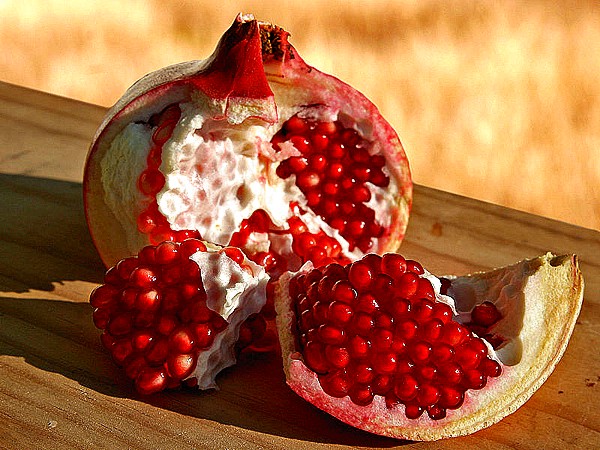
La grenade (Punica granatum), de la famille des Lythracées est le fruit comestible du grenadier. Elle est probablement originaire d'Iran et réputée avoir des vertus thérapeutiques.
Le grenadier est un arbuste qui aime la chaleur et craint les grands froids. Il s'acclimate bien tout autour du bassin méditerranéen, dans la même zone climatique que l'olivier.
Originellement, le sirop de grenadine était tiré des grenades. Aujourd'hui, la grenade n'entre plus dans la composition du sirop de grenadine industriel qui est un mélange de fruits rouges.
Le nom de grenade, aussi appelée pomme-grenade ("pomegranate" en anglais), vient du latin granatus qui signifie « abondant en grains ».
Description
C'est une grosse baie ronde, de la taille d'une grosse orange, à écorce dure et coriace, de couleur rouge ou jaune-beige, qui renferme dans des « loges » délimitées par des cloisons épaisses, de nombreux pépins de couleur rose-saumon à rouge rubis, d'une forme caractéristique en gemme de rubis.
Dans chaque pépin, la graine est enrobée d'une pulpe gélatineuse de chair rouge transparente, sucrée chez les variétés améliorées, sinon d'un goût plutôt âcre. Seuls les pépins constituent la partie comestible de la grenade soit environ la moitié du fruit.
Avec la maturité, la peau de la grenade s'assombrit, s'amincit et durcit à l'extrême. Son écorce constituant alors une protection efficace pour la pulpe enfermée à l'intérieur de très nombreuses cloisons ténues.
Histoire
Originaire de la Perse (Iran), elle est cultivée depuis au moins 5000 ans en Asie occidentale et en Afrique du Nord, elle poussait dans les jardins suspendus de Babylone; elle est représentée sur certains bas-reliefs du temple de Karnak (Égypte), sur des mosaïques byzantines à Qasr el-Libia en Libye, un arbre de vie au-dessus de deux pintades et la grenade représentée sur des sculptures assyriennes.
Les anciens Égyptiens préparaient avec elle un vin léger au goût de framboise. Les Grecs la considéraient comme le symbole de la fertilité, elle était d'ailleurs dédiée à la déesse de l'amour et des plaisirs Aphrodite et à Héra la déesse du mariage légitime qui fut l'épouse de l'infidèle Zeus, c'est elle qui enverra aux enfers Perséphone pour en avoir prélevé un grain de celle que lui présenta Hadès; ce fut aussi l'un des attributs de Dionysos.
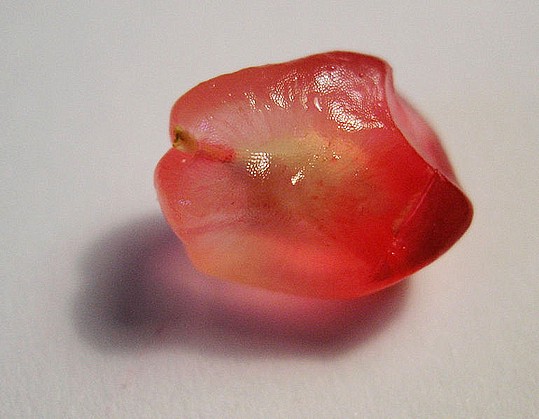
Elle fut introduite en Europe dans le courant du VIII siècle par les Arabes via l'Espagne où elle fut abondamment cultivée en Andalousie dans la province qui portera son nom, ainsi que la ville d'Elvira, qui sera rebaptisée Grenade au XI siècle par Zawi ibn Ziri, premier roi de la dynastie berbère-ziris (1012-1090).
La grenade était appréciée des nomades car, protégée du dessèchement par sa peau épaisse et coriace, les caravanes pouvaient la transporter sur de longues distances, et son jus désaltérant et nourricier était très apprécié. On retrouve sa trace dans des documents anciens.
Hippocrate recommandait le jus de la grenade contre la fièvre et comme fortifiant contre la maladie. Les Romains connaissaient la grenade grâce aux Phéniciens qui l’apportaient de la Phénicie (Liban) à Rome, d’où son nom scientifique de Punica.
La Bible y fait plusieurs fois référence, et la grenade pourrait bien être le fruit défendu. Le prophète Mahomet pensait que la grenade chassait l’envie et la haine. Ce sont les Berbères (Maures) qui ont apporté le fruit en Europe, et la ville espagnole de Grenade, fondée au X siècle, lui doit son nom.
Beaucoup de peuples ont vu la grenade, comme un symbole d'amour, de fertilité et de prospérité.
Selon la mythologie grecque, le premier grenadier est censé avoir été planté par Aphrodite, la déesse grecque de l’amour et de la beauté, et Hadès, le dieu des Enfers, l’offrit à la belle Perséphone pour la séduire.
À Java, elle est associée à certains rites accompagnant la grossesse.
Selon Shakespeare, c’est sous son feuillage que Roméo s’abrita pour chanter une sérénade à Juliette.
En Chine, la coutume veut qu’on offre une grenade aux nouveaux époux en guise de promesse d’une nombreuse descendance.
Production
Les principaux pays producteurs sont: l'Iran, Israël, le Liban, l'Égypte, la Tunisie, l'Espagne et l'Italie.Variétés:
À fruits - Fine Tendral, Gabès, Mekens, Mollar de Elche, Provence, Maroc, Gafsa, Seedless, Wonderfull, Sweet, Plentiflora, Flavescnes, Albescent.
Décoratives - Sans fruits ou Naines: Flore Pleno, Luteum Plenum, Legrelliae, Maxima Rubra, Nana.
Utilisation
Le fruit se mange nature à
décortiquer grain par grain et il est très apprécié des enfants. Il peut
être utilisé pour faire des sorbets, des boissons, du sirop de grenadine
artisanal, qui entre comme ingrédient dans des plats cuisinés.
À l'achat, sélectionnez les grenades dont l'écorce est foncée, d'un rouge
profond à brun. Les petites grenades sont ordinairement sèches, ligneuses,
âcres et immangeables. Plus le fruit est lourd, plus la pulpe sera juteuse.
L'épiderme doit être bien lisse et brillant, exempt de brunissures. On dit
que le fruit est mûr lorsqu'en tapant dessus, il émet un son métallique.
Dans la cuisine libanaise, le sirop de grenadine, appelé Rab er‘remane est confectionné à partir des variétés acides qui lui donne une saveur douce et légèrement acidulée. Ce sirop est utilisé dans de nombreux plats salés pour leur conférer une agréable acidité, telles, les mtabba, aubergines grillées à la crème de sésame, la baba ghannouj, purée d’aubergines grillées à l'ail et la lahm b'ajine, pizza à la viande.
Dans la cuisine du Punjab, au nord de l'Inde, ses graines séchées sont utilisées comme épice dans des plats végétariens, auxquels elles apportent un goût aigrelet.
La cuisine iranienne lui réserve aussi une place importante. Le jus de grenade et le concentré de grenade sont très courants en Iran. Son concentré est utilisé dans différents plats et en particulier le fessenjan, un plat délicieux (accompagné du riz) avec du canard, noix haché et concentré de grenade.
Une grenade fournit 40% des AJR en vitamine C. C'est aussi une source importante d'acide folique et d'antioxydants (polyphénols). Les polyphenols de la grenade (punicalagines) sont des tannins hydrolysables.
De nombreux fabricants de compléments alimentaires utilisent de l'extrait de grenade (non sucré, 0 calorie), à la place du jus. Ces extraits sont souvent de l'acide ellagique provenant du processus d'extraction du jus et non absorbé par l'organisme. D'autres extraits sont décrits comme étant des 'punicosides', néologisme inventé par d'habiles équipes marketing mais inconnu du monde scientifique. Seul le terme punicalagine est signe de qualité.
L'extrait de peau de la grenade contient de puissants antioxydants polyphénoliques qui semblent inhiber le développement de l'athérosclérose, réduire le risque de maladie cardio-vasculaire et influer sur l'hypertension. La grenade permet également de réduire la pression sanguine systolique en inhibant l'enzyme de conversion du serum d'angiotension (ACE).
Des recherches suggèrent que la grenade pourrait également être efficace contre le cancer de la prostate et l'ostéoarthrite.
La grenade est utilisée en médecine traditionnelle: elle augmente la libido en luttant contre les troubles d'érection, en gargarisme, elle soigne les toux persistantes, elle est efficace en cas de fièvre, de diarrhées, de colique et peut aussi servir de vermifuge.
Les fibres de la grenade, majoritairement insolubles, sont irritantes et donc contre-indiquées aux personnes souffrant de diverticules.
Des graines roses de la grenade, on extrait une boisson, le « sambu ». Elle est utilisée dans des cures de régénération et de nettoyage interne qui, selon ses préparateurs, permettrait aussi d'aider à perdre le surpoids.
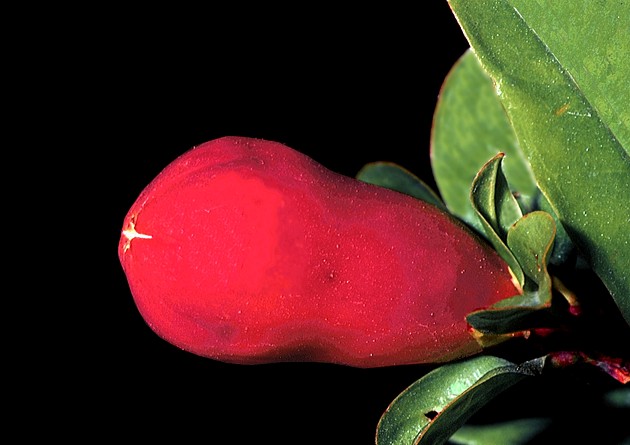
foto Elio Corti - 1972
La granada es la fruta del árbol del granado (Punica granatum) especie del género Punica, dentro de la familia Lythraceae.
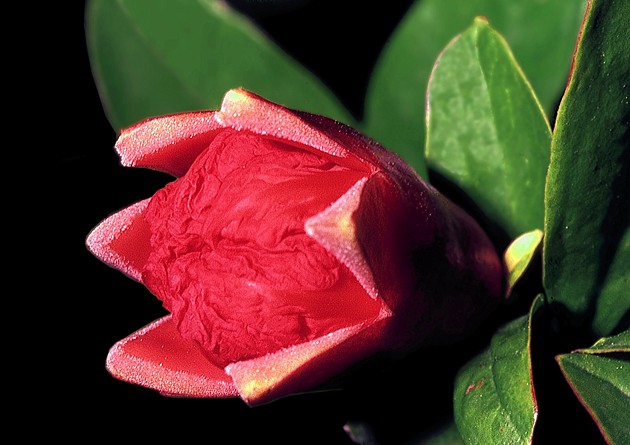
foto Elio Corti - 1972
Etimología
Granada abierta mostrando sus semillas o "granos". El nombre del género, Punica, deriva de fenicios, quienes fueron unos difusores activos de su cultivo, en parte por razones de tipo religioso. El nombre de la especie granatum deriva del adjetivo del Latín granatus, que significa 'con granos' (debido a las semillas del fruto/grana: el arma granada más tarde derivaría del nombre de la fruta). Sin embargo, en el Latín clásico el nombre de la especie era malum punicum ó malum granatum, en donde "malum" es manzana. Esto ha influido en el nombre pomegranate (en inglés), que se le da en muchos idiomas (ej. alemán Granatapfel, manzana con semillas). Incluso "pomegranate" tiene este mismo significado; pomum es el nombre en latín para manzana.
Otra raíz muy extendida para "granada" es la egipcia y la semítica rmn. Encontrándose en el antiguo egipcio, y en el hebreo rimmôn, y en el árabe rummân, esta raíz ha pasado del árabe a otro gran número de lenguas, incluida el portugués (romã).
Descripción
El granado es un arbusto caducifolio que puede alcanzar de 5 a 8 m de altura. Las hojas son opuestas ó sub-opuestas, brillantes, oblongas estrechas, enteras, de 3 a 7 cm de longitud y 2 cm de anchura. Las flores son de un color rojo brillante, de 3 cm de diámetro, con cinco pétalos (normalmente más en las plantas cultivadas).
Su fruto es una baya globular con una corteza coriácea, el interior esta subdividido en varios lóbulos que contienen numerosas semillas revestidas con una cubierta, llamada sarcotesta, de pulpa roja y jugosa. Se abre espontáneamente al llegar la madurez por fisuras que dejan al descubierto el contenido de cada lóculo; las aves son atraídas por el color vivo de las sarcotestas, y consumen las semillas que así son transportadas con sus heces. Es un caso notable de dispersión endozoócora.
Tiene como área de distribución la misma que la naranja y el olivo, dándose muy bien en zonas semiáridas.
Historia
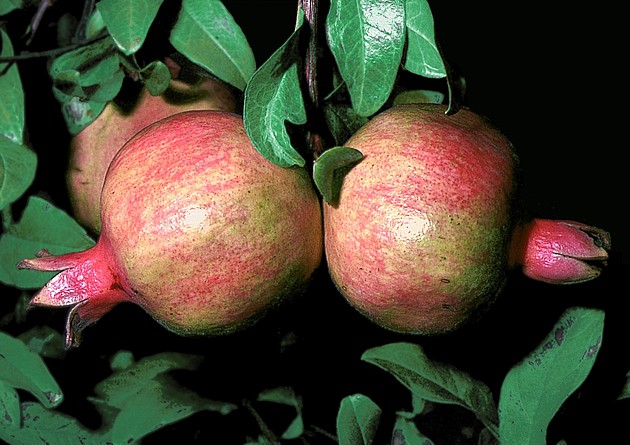
foto Elio Corti - 1972
El fruto es originario de una región que abarca desde Irán hasta el norte de los Himalayas en India, y fue cultivado y naturalizado en toda la región del Mediterráneo incluyendo Armenia desde la Antigüedad. Muy apreciada en las zonas desérticas, por estar protegida de la desecación por su piel gruesa y coriácea, lo que permitía que las caravanas la pudieran transportar grandes distancias, sin que le afectara en la conservación de sus cualidades tan apreciadas. Se encuentran sus huellas en todos los documentos antiguos.
Se sabe del cultivo de la granada, desde hace al menos 5000 años en Asia occidental y en el Norte de África; se encontraba en los jardines pensiles de Babilonia y en los bajorrelieves egipcios. Los antiguos egipcios preparaban con su jugo un vino ligero con sabor a frambuesa.
Hipócrates recomendaba el jugo de la granada contra la fiebre y como fortificante contra la enfermedad. Los romanos conocieron la granada gracias a los fenicios que la trajeron de Fenicia (aproximadamente el actual Líbano) a Roma, de ahí su nombre científico de Punica.
La Biblia hace referencia en numerosas ocasiones a este fruto, y siempre en su defensa. Son los bereberes quienes traen la fruta a Europa, y la ciudad andaluza de Granada, fundada en el siglo X, recibió su nombre.
Muchos pueblos han visto en la granada como un símbolo de amor, de fertilidad y de prosperidad.
Según la mitología griega, el primer granado fue plantado por Afrodita, la diosa griega del amor y de la belleza, mientras que el dios del infierno Hades, le ofreció su fruto a la bella Perséfone para seducirla.
En Java, está asociada a ciertos ritos que acompañan el embarazo.
Según Shakespeare, bajo su follaje se ocultó Romeo para cantarle una serenata a Julieta.
En China, se tiene la costumbre de ofrecerle una granada a los recién casados como auspicios de una descendencia numerosa (el color rojo de esta fruta es considerado por la tradición china un color que atrae la buena fortuna).
Producción
Los principales países productores son: Israel, Líbano, Egipto, Tunicia, España e Italia. Variedades:
De frutos - Fine Tendral, Gabès, Mekens, Mollar de Elche, Provence,
Maroc, Gafsa, Seedless, Wonderfull, Sweet, Plentiflora, Flavescnes, Albescent.
Decorativas - Sin frutos o enanas: Flore Pleno, Luteum Plenum, Legrelliae, Máxima
Rubra, Nana.
Usos
La fruta se come natural grano a grano, apartando la corteza y las laminillas amargas que separan las celdas donde se encuentran. Es muy apreciada por los niños. Se puede utilizar para hacer sorbetes, de bebidas, de sirope de granadina artesanal, que entran como ingredientes en los platos cocinados.
Al comprarlas, seleccione las granadas que presenten un color rojo profundo a marrón. Las granadas pequeñas normalmente están secas, leñosas, acres e incomibles. Entanto que el fruto sea más grande, la pulpa será más jugosa. La epidermis debe de estar bien lisa y brillante, exenta de marcas. Se dice que la fruta está madura cuando presionándola un poco emite un ruido metálico.
En la cocina libanesa, el sirope de granadina, llamado Rab er‘remane se confecciona a partir de las variedades ácidas que lue dan un sabor dulce y ligeramente acidulado.
Su sirope se utiliza en numerosos platos salados para darles agradable acidez, tal como, las (mtabba), berenjenas horneadas a la crema de sésamo, puré de berenjena horneada al ajo (baba ghannouj) y la (lahm b‘ajine) pizza libanesa con guarnición.
En la cocina de Punjab, al norte de la India, sus granos secos se utilizan como especia en los platos vegetarianos, a los que aportan un gusto agridulce. La cocina iraní le reserva así mismo un lugar importante.
Es una de las llamadas "superfrutas" por los compuestos químicos de acción positiva que posee: es rica en antioxidantes y potasio, calcio, magnesio, hierro, manganeso, cobre, zinc y vitaminas C, B, E.
La granada se utiliza en la medicina tradicional:
En gargarismos, alivia la tos persistente, y es eficaz en caso de fiebre, de diarreas, de cólico y puede servir también de vermífugo. Tiene ligeras propiedades diuréticas y antihipertensivas.
Las fibras de la granada, mayoritariamente insolubles, son irritantes y están contraindicadas en las personas que padecen de divertículos ó de irritación cólica aunque son muy beneficiosas para quienes son propensos a los estreñimientos o constipados y al tránsito intestinal lento.
De los granos rosas de la granada, se extrae una bebida, el « sambu», utilizada en las curas de regeneración y de limpieza interna que, según sus preparadores, permite además ayudar a perder sobrepeso.
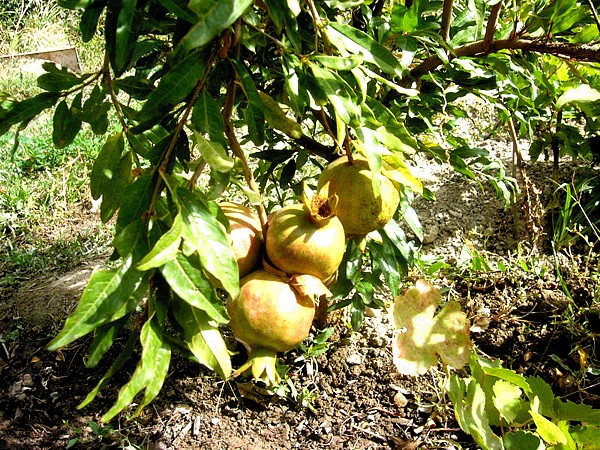
melograno - varietà bianca